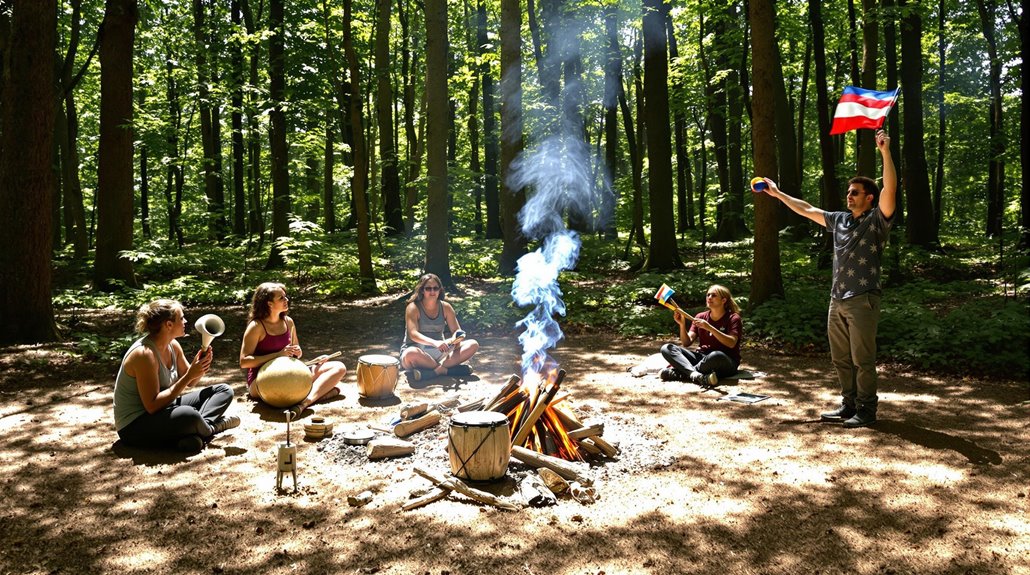How to Communicate Without Electronics: Low-Tech Survival Methods

When electronic devices go down, you can rely on low-tech methods like smoke signals and Morse code. Smoke signals use different colored smoke to communicate over short distances and signal distress. Mirrors reflecting sunlight offer another option for long distances. For audible communication, use whistle codes or drum patterns to convey messages across vast areas. Mastering Morse code using light flashes can also be effective. Prepare by assembling a kit with mirrors, whistles, and flashlights, and practice these methods regularly. By mastering these techniques, you're equipped to stay connected, and there's more to uncover about these skills.
Understanding Low-Tech Communication
In a world dominated by electronic communication, exploring low-tech methods like smoke signals and Morse code can be both fascinating and practical. These low-tech communication methods offer reliable alternatives when modern technology isn't available, using visual signals and auditory cues to deliver messages effectively. Smoke signals, for example, are an ancient technique that can indicate distress or communicate over short distances. By manipulating different colors of smoke, you can convey specific meanings, making it an effective communication tool in survival situations.
Morse code, another versatile method, employs a series of dots and dashes to represent letters. You can transmit Morse code through light, sound, or even visual signals like mirrors. It's a valuable skill for discreet communication, especially when you need to send messages without attracting unwanted attention. Tapping codes, such as the tap code, historically allowed for secretive exchanges through rhythmic tapping on surfaces. This method is particularly useful when you require a stealthy approach.
For these methods to work, a clear line of sight or unobstructed transmission path is essential. In survival situations, mastering these techniques can make a significant difference, enabling you to communicate effectively without relying on electronic devices.
Visual Signaling Techniques
Shifting from auditory to visual methods, visual signaling techniques offer a reliable way to communicate when electronics aren't an option. Smoke signals, a classic example, can convey distress or calls for help. You can use different colors, like white smoke, to signal an emergency. Practicing this method guarantees your signals remain clear and effective.
Light signals, like using mirrors to reflect sunlight, can reach search and rescue teams even from several miles away. Aiming the reflection correctly is essential, so regular practice is key. This technique optimizes visibility and communication efficiency over long distances.
Ground-to-air symbols also serve as significant communication tools. By following the CLASS principle—contrast, location, angularity, size, and shape—you can create symbols that stand out to aerial rescue teams. Making these symbols large and using reflective items, such as aluminum foil, increases their visibility, enhancing your chances of being spotted from above.
Incorporating these visual signaling techniques into your emergency preparedness toolkit guarantees you're ready when electronics fail. Strategic placement and height variation of lanterns can play an essential role in maximizing visibility and ensuring effective communication when traditional methods are unavailable. Regular practice and understanding these methods can make a decisive difference in communication during emergencies, increasing your chances of successful rescue and survival.
Audible Signal Methods
When electronics fail, and you need to communicate over a distance, audible signal methods offer a reliable alternative. Whistle codes can effectively convey complex messages if you maintain consistent patterns for clarity and recognition. These codes are crucial in situations where verbal communication is impractical. In a wilderness setting, drum patterns can relay messages across significant distances. You can improve their effectiveness by employing natural sound amplification, guaranteeing your signals are heard far and wide.
Mimicking natural sounds, such as bird calls or rustling leaves, allows your communication to blend seamlessly with the environment. This technique can be particularly useful in avoiding unwanted attention from potential threats. Clapping stones together creates familiar sounds that signal your presence or alert others nearby, proving essential in the wilderness.
To optimize communication efficiency, establish a set of predefined signals with your group. This shared understanding minimizes confusion and guarantees swift, accurate exchanges. When verbal communication is hindered by distance or environmental factors, these methods offer actionable solutions. By adapting these low-tech strategies, you maintain crucial communication links, guaranteeing safety and coordination in challenging situations where electronics might not be an option.
Light-Based Communication
For effective communication when electronics aren't available, light-based signals offer a compelling solution. Utilizing light flashes, you can convey messages over long distances using Morse code. This involves a series of dots and dashes represented by light signals from a flashlight or signal mirror. In an emergency situation, a signal mirror can reflect sunlight to create powerful signals visible from several miles away, making it an invaluable communication tool.
You can also use colored lights or flares to convey different messages. Specific colors, based on pre-established codes, signal distress, demand attention, or indicate an all-clear status. These light signaling techniques provide an efficient means of communication, especially when verbal communication isn't feasible.
For nighttime operations, starlight scopes and infrared flashlights enable covert signaling. This allows for discreet communication, ensuring you don't alert potential threats. Enhancing your ability to communicate in emergencies, these tools offer a balance between visibility and stealth.
When navigating urban debris and hazards, understanding the importance of adjustable beams in flashlights helps in maximizing visibility and safety. Regular practice with these techniques, such as mastering quick extinguishing methods for signal fires, increases their effectiveness and safety. Remember, in a pinch, these non-electronic signals can save lives, so familiarize yourself with these vital methods.
Preparing for Off-Grid Scenarios

Building on the principles of light-based communication, preparing for off-grid scenarios involves equipping yourself with a variety of low-tech signaling techniques. Understanding these methods, like smoke signals and Morse code, guarantees you have reliable emergency communication options when electronic devices fail. Your emergency preparedness isn't complete without a thorough grasp of these techniques.
Start by evaluating your environment. This step is vital for choosing the right signaling techniques, as visibility and sound transmission vary greatly in different terrains. Regardless of whether you're in a dense forest or an open field, understanding your surroundings will help you decide which non-verbal communication methods to use.
Creating a low-tech signal kit is fundamental. Include items like compact mirrors, whistles, and flashlights. These simple tools can become effective communication devices for sending distress signals and attracting attention in off-grid scenarios. Regularly practicing these techniques builds confidence and improves your ability to communicate without electronics.
Additionally, practice non-verbal communication methods with your group. Tap codes and visual signals increase coordination and guarantee successful communication during emergencies. By honing these skills, you'll be ready to tackle any situation where modern technology is unavailable. Remember to store a minimum of 1 gallon of water per person per day to ensure hydration needs are met during emergencies.




